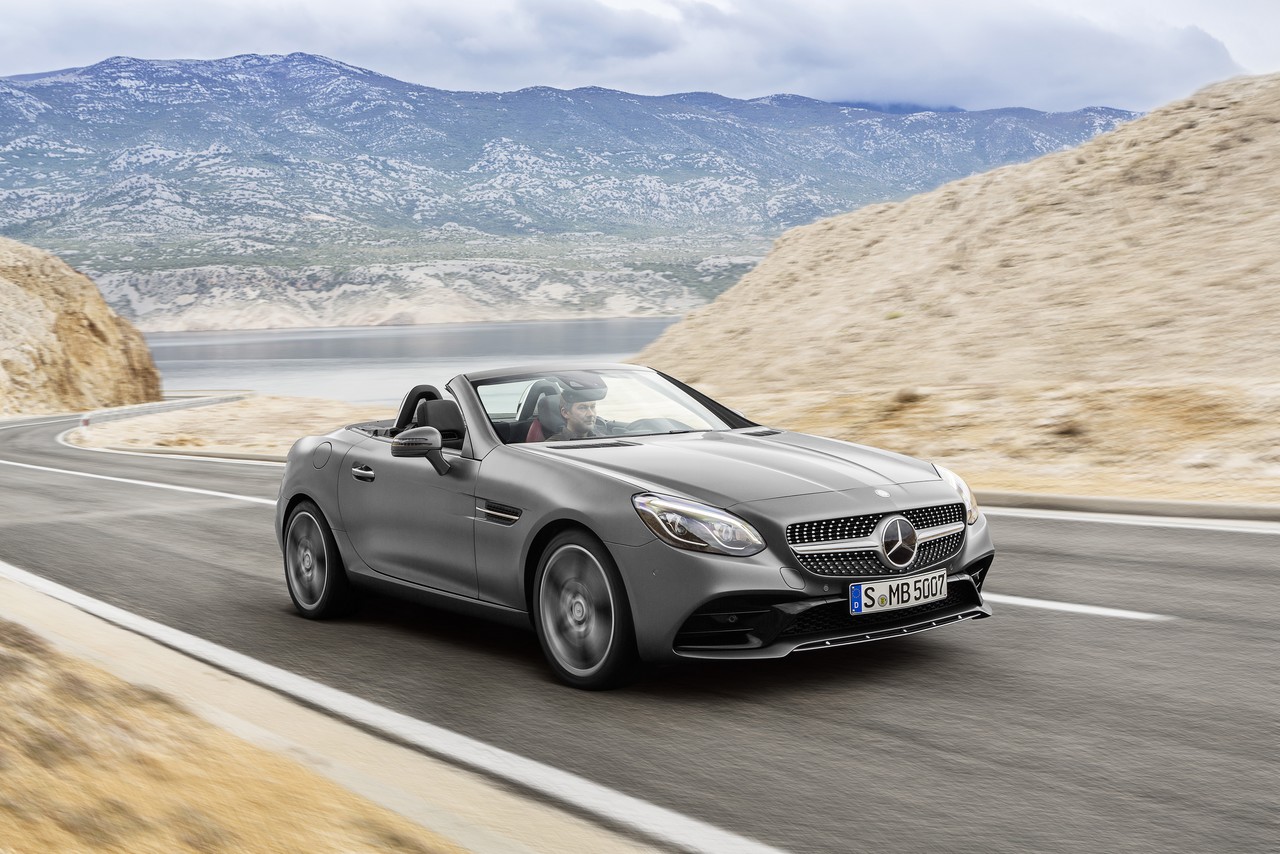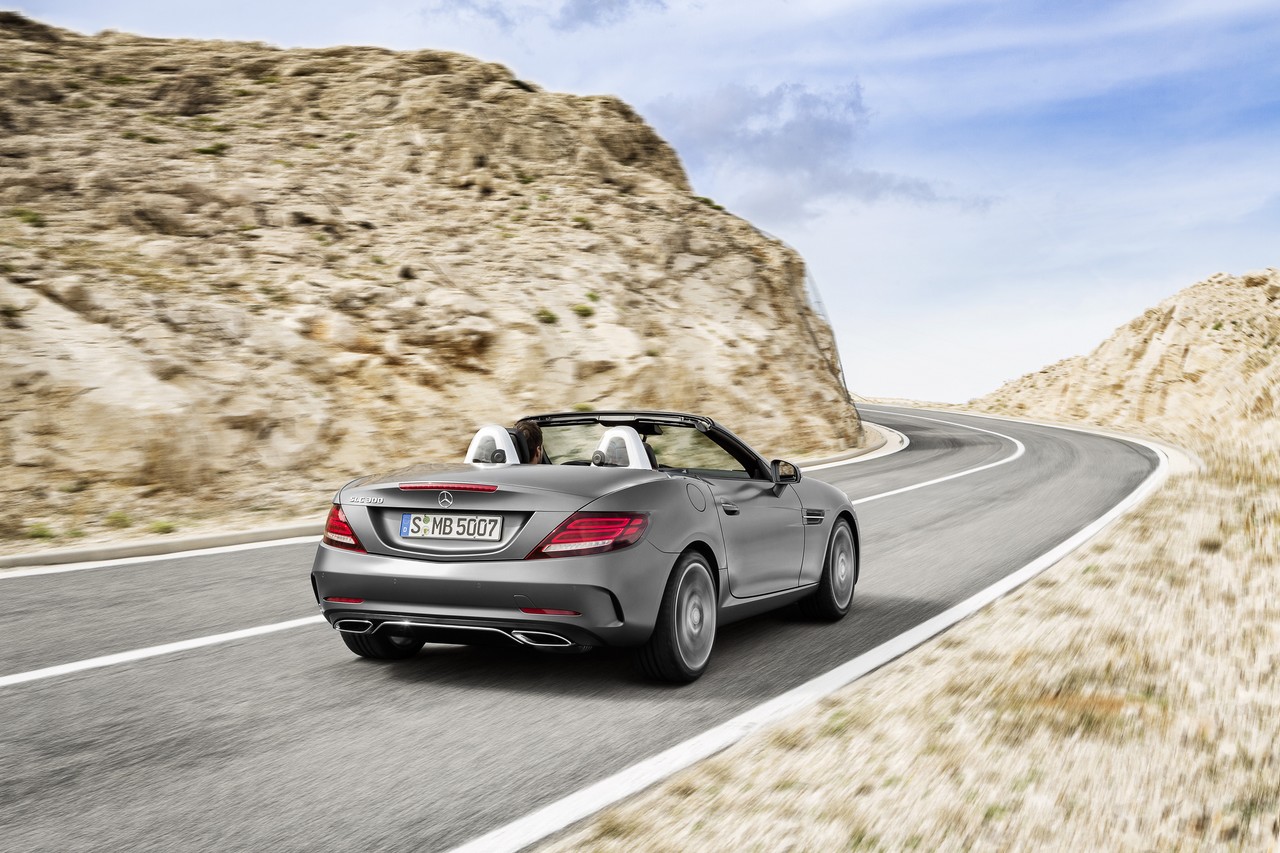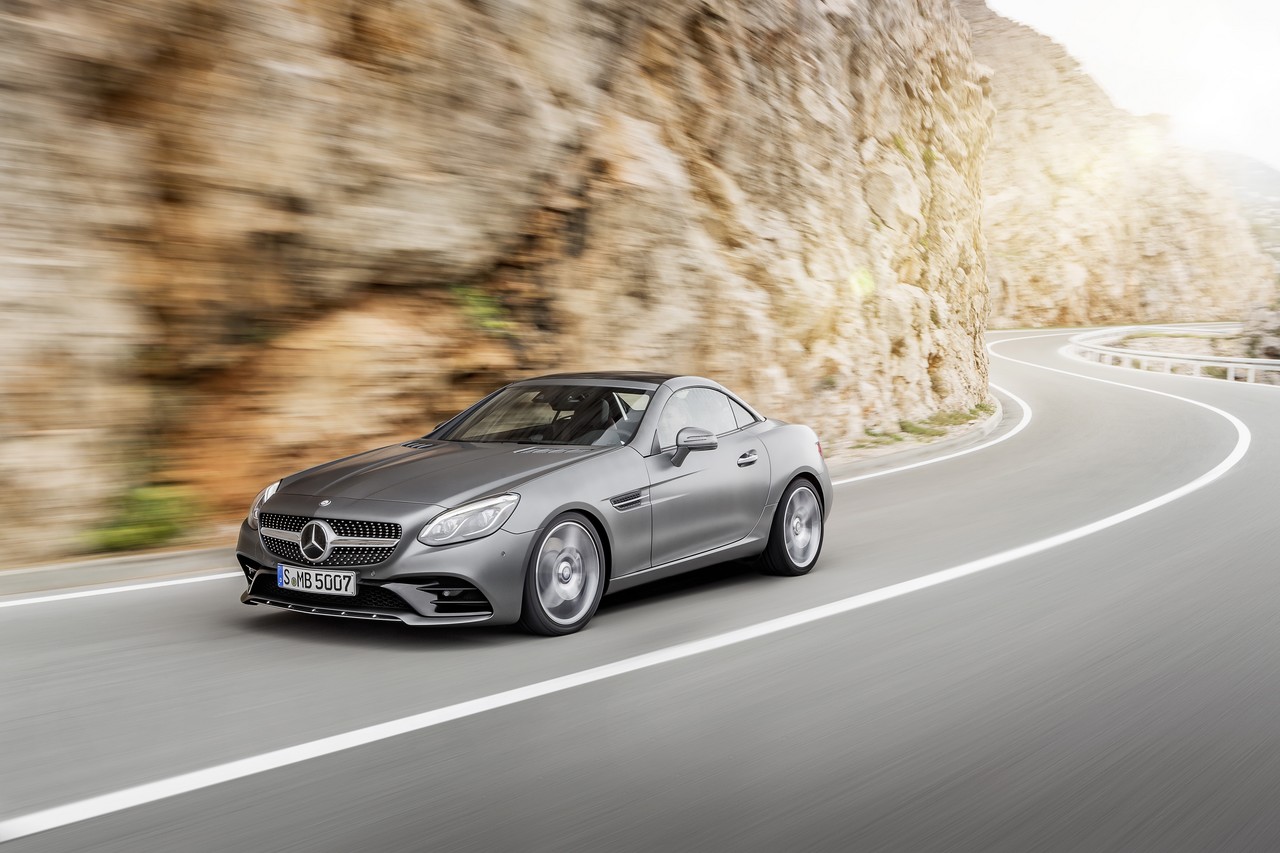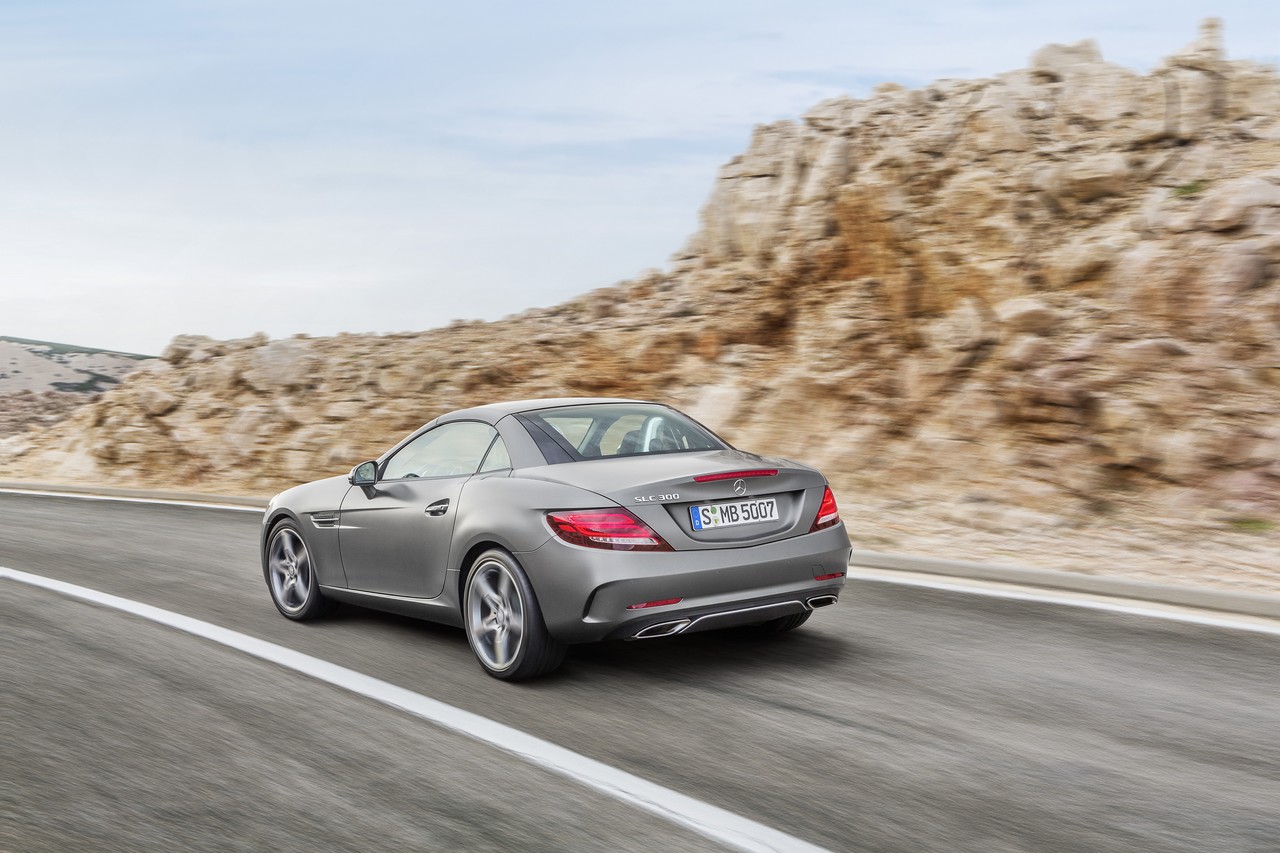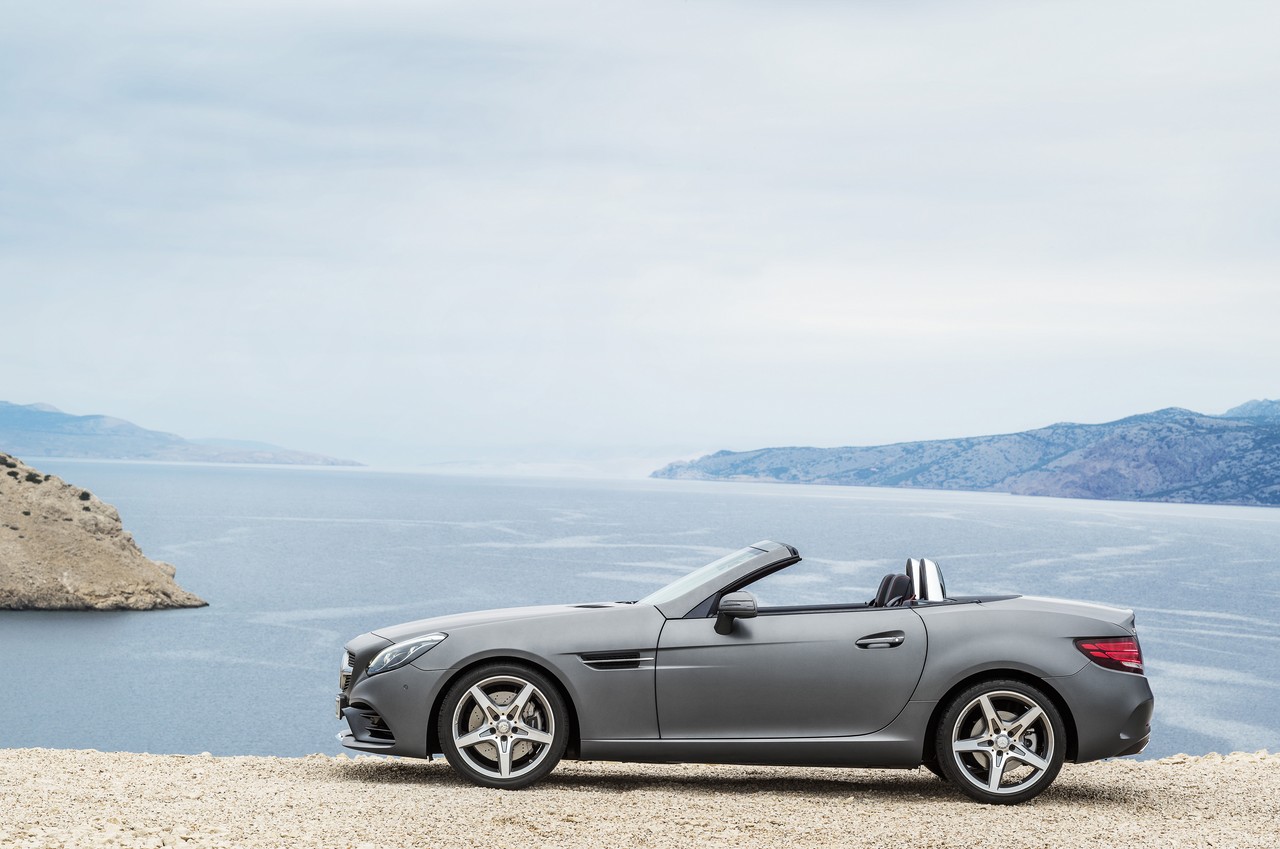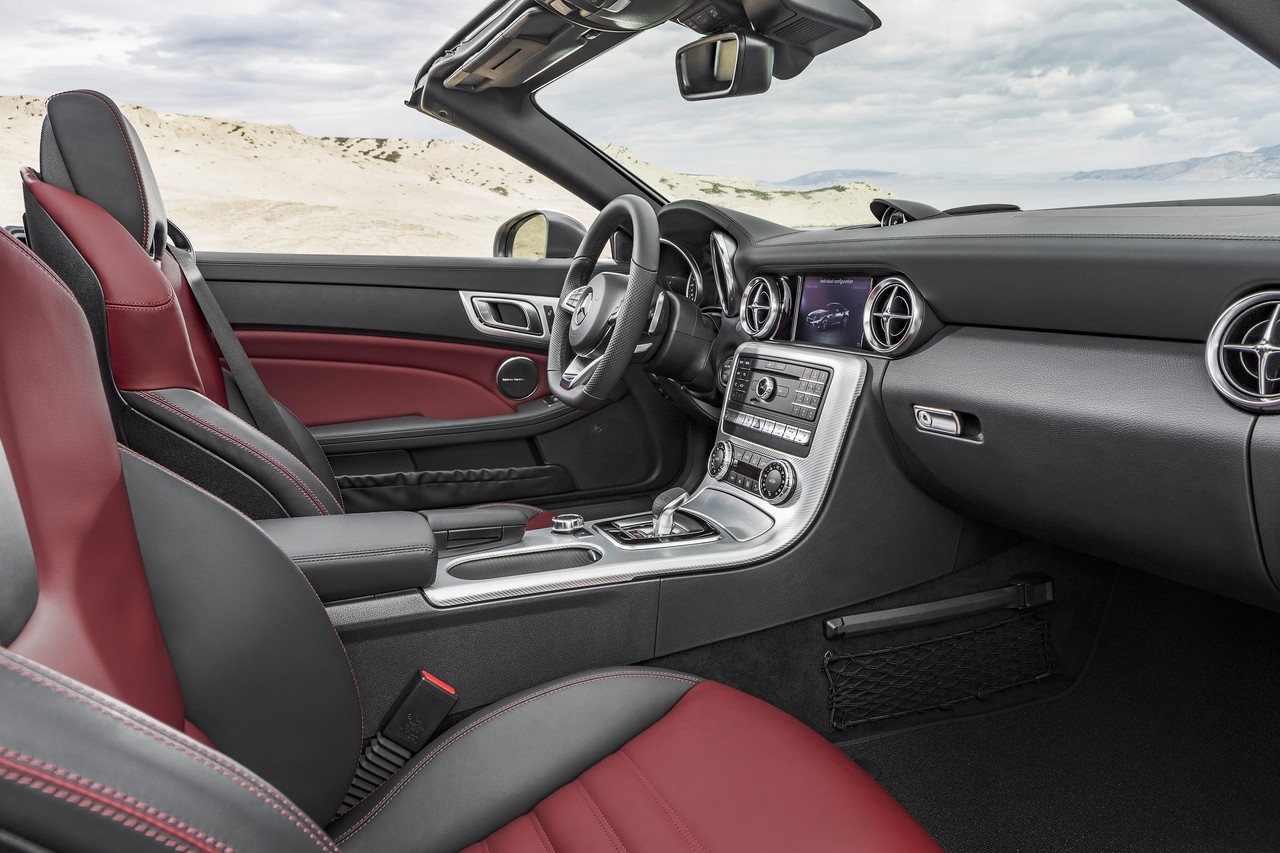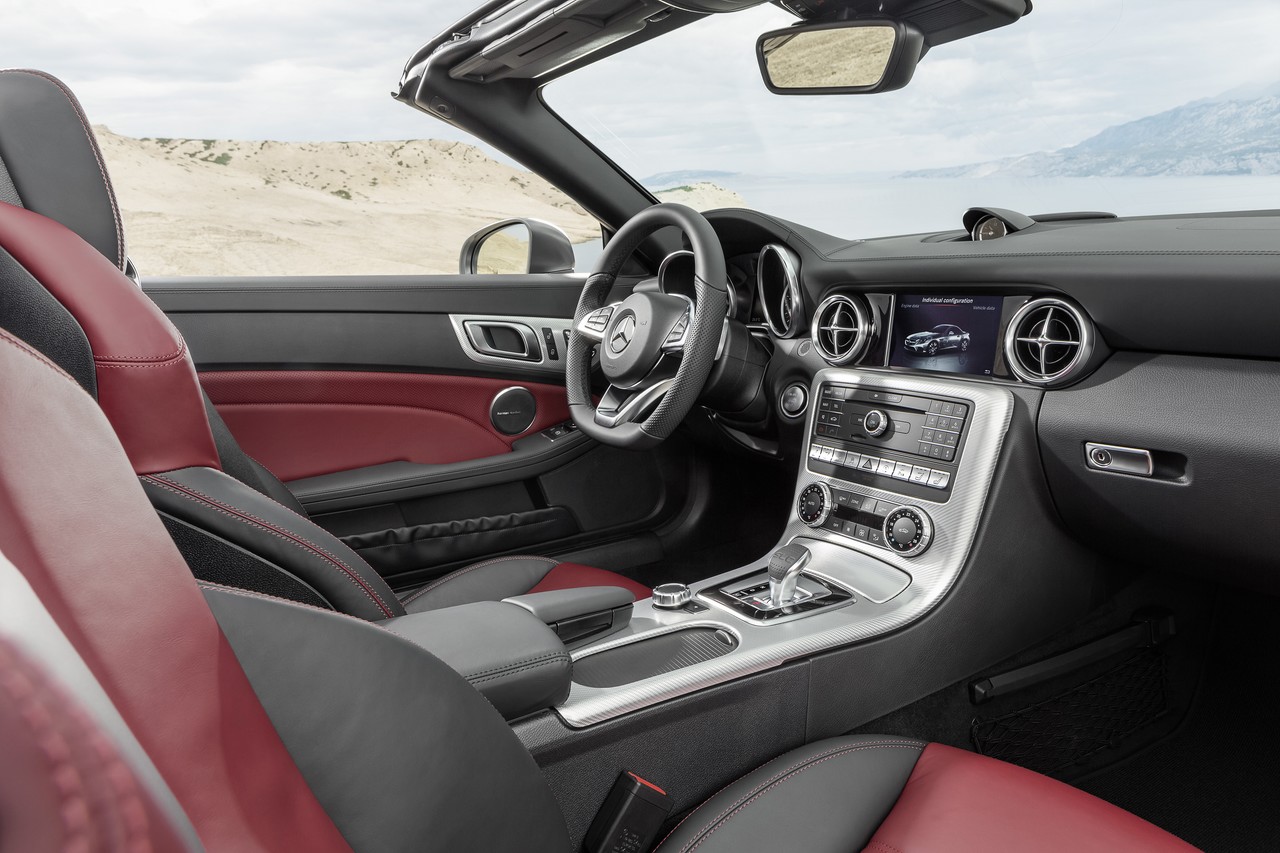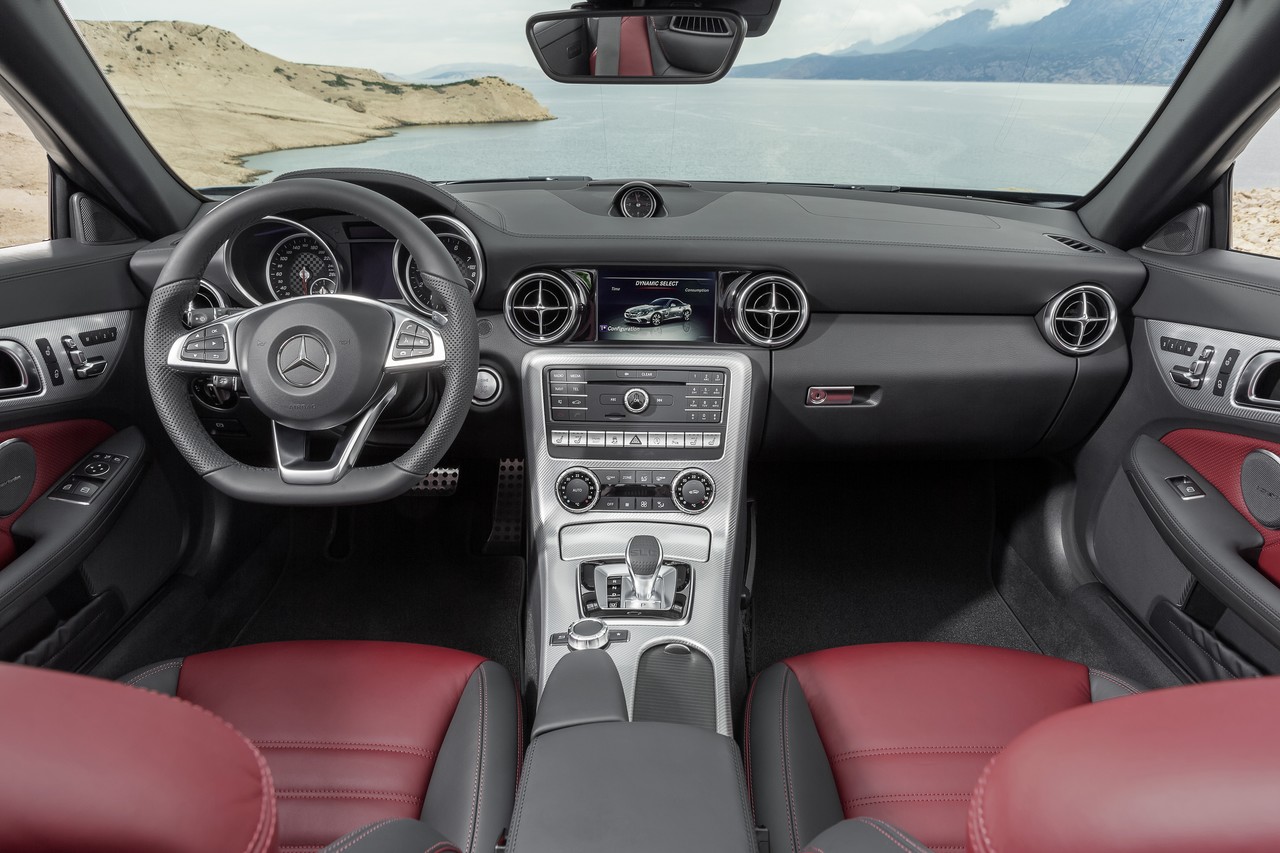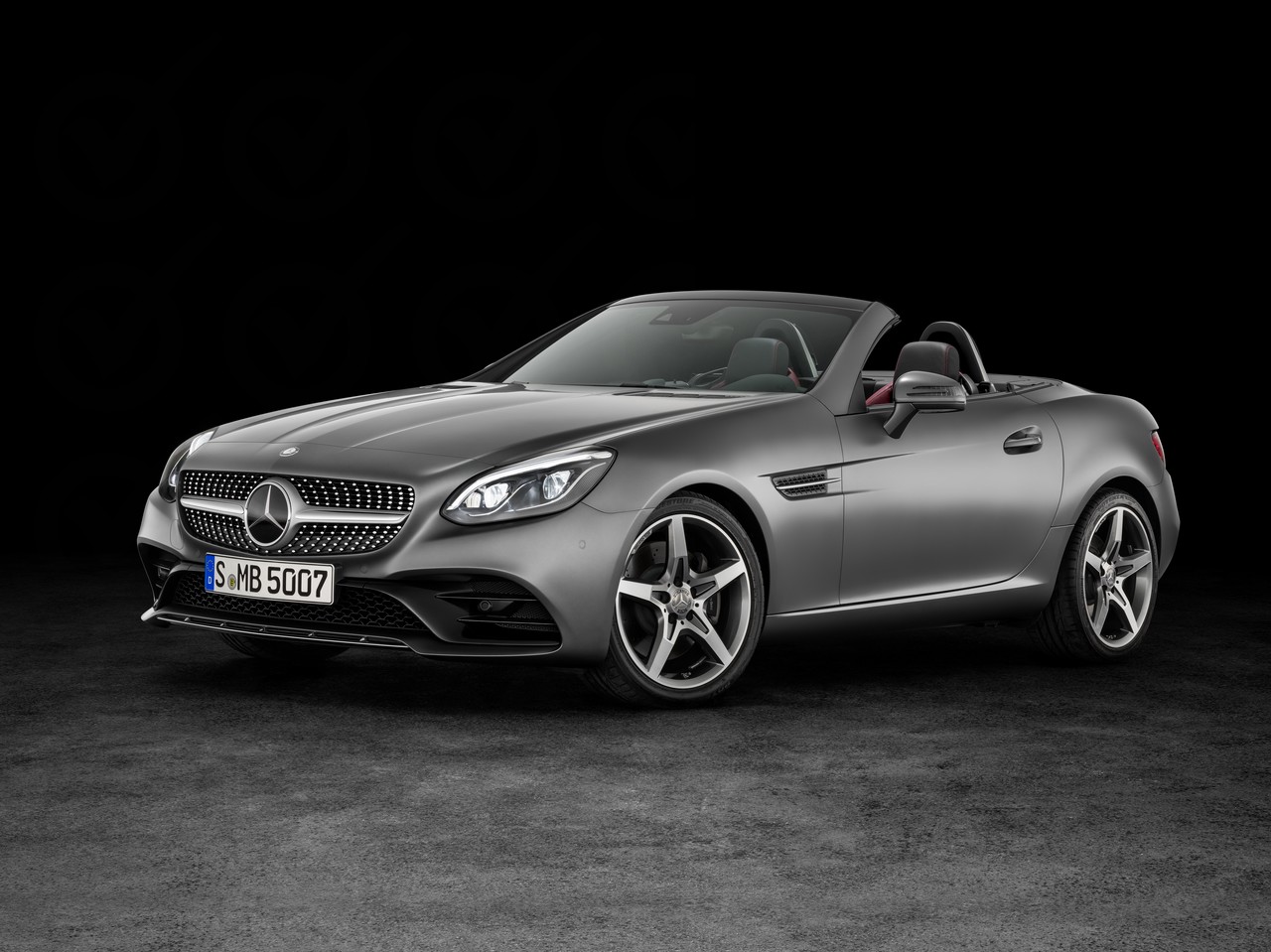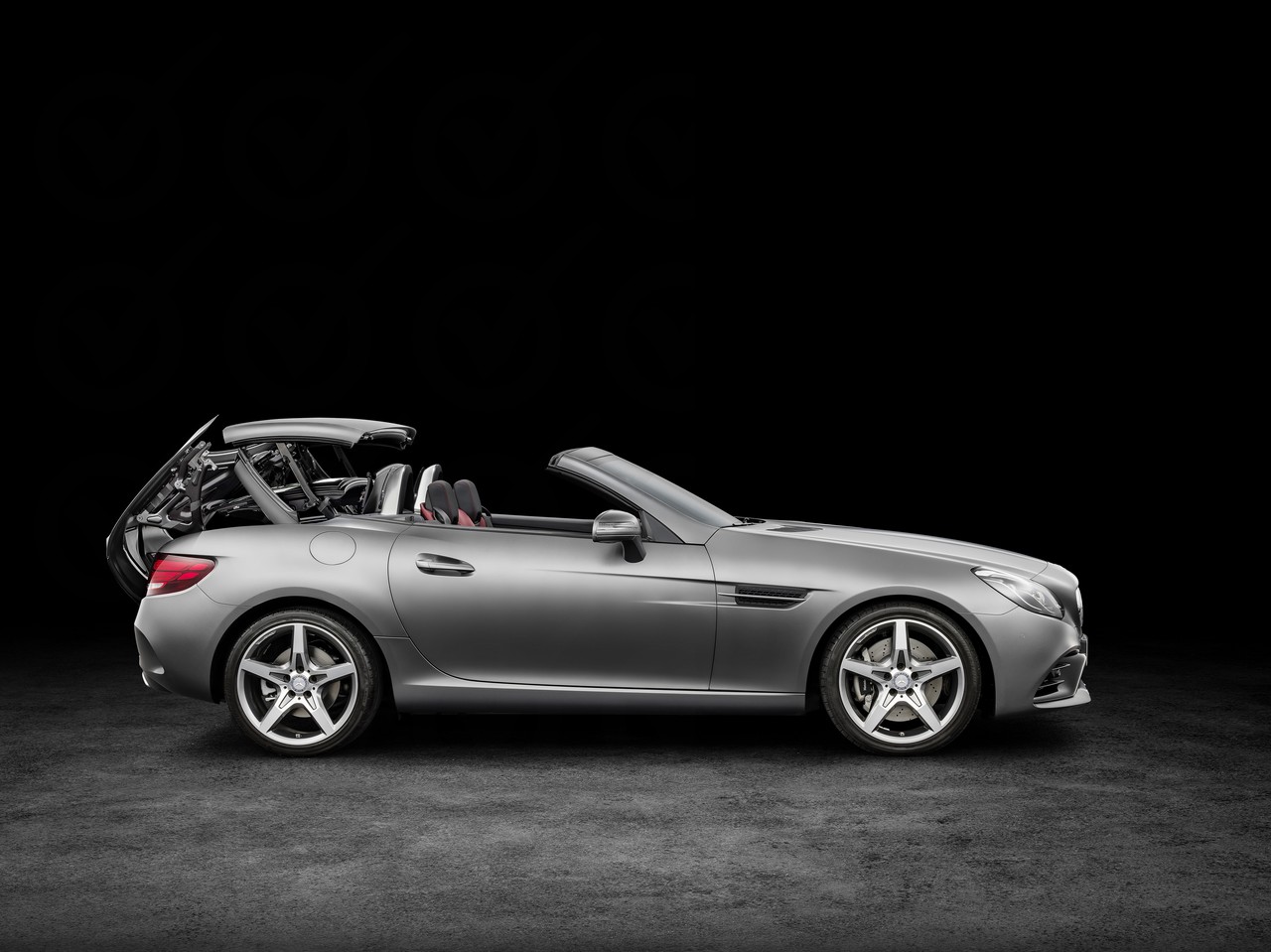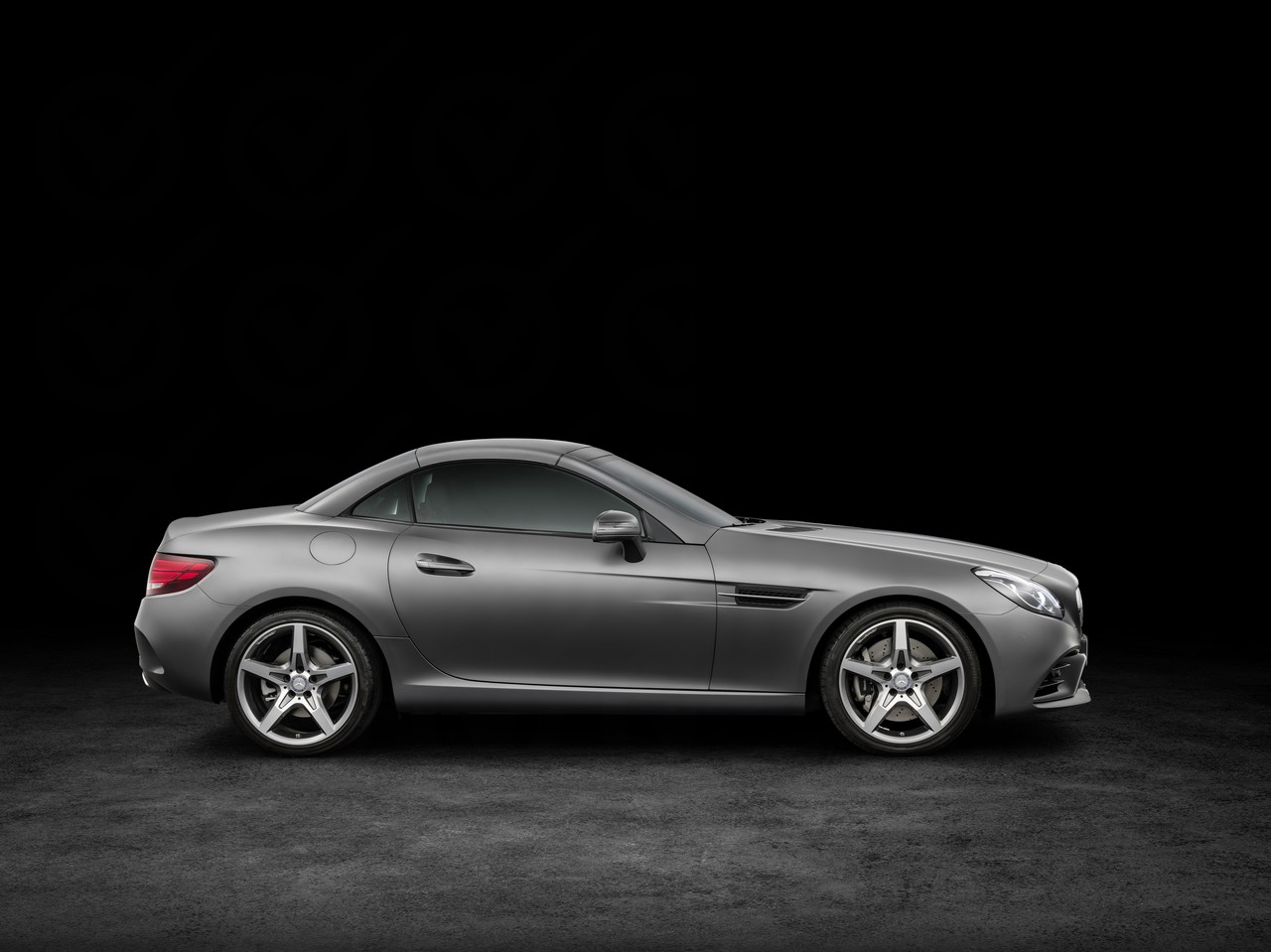
- Fuel-efficient powertrains
- Accomplished dynamics
- Supportive front seats
- High standard of interior fit and finish
- Steering is accurate and well-weighted
- Steering feel?
- Suspension compliance?
- Tyre noise on coarse surfaces?
- Sensitive and abrupt ESC intervention?
Overview
Commencing production in January 2016, the Mercedes-Benz R172 SLC was a two-seat convertible with a retractable hardtop roof. Manufactured in Bremen, Germany, the rear-wheel drive Mercedes-Benz SLC replaced the R172 SLK ; according to Mercedes-Benz, the change to the SLC name acknowledged the relationship with the C-Class with which the SLC shared technology.
For Australia, the R172 SLC range consisted of the SLC 180, SLC 200 and SLC 300. Please note that the Mercedes-AMG R172 SLC 43 has been reviewed separately.
| Engine | Trans. | Peak power | Peak torque | |
|---|---|---|---|---|
| SLC 180 | 1.6-litre M274 turbo petrol I4 | 6sp man., 9sp auto |
115 kW at 5300 rpm | 250 Nm at 1200-4000 rpm |
| SLC 200 | 2.0-litre M274 turbo petrol I4 | 6sp man., 9sp auto |
135 kW at 5500 rpm | 300 Nm at 1200-4000 rpm |
| SLC 300 | 2.0-litre M274 turbo petrol I4 | 9sp auto | 180 kW at 5500 rpm | 370 Nm at 1300-4000 rpm |
Dimensions and body
Compared to the Mercedes-Benz R172 SLK which it replaced, the R172 SLC was 8 mm shorter (4138 mm) and 7 mm narrower (1810 mm), though height (1307 mm) and wheelbase length (2430 mm) were unchanged. Visually, the R172 SLC could be identified by its steeply raked ‘diamond’ radiator grille which was designed to extend the appearance of the arrow-shaped bonnet. The R172 SLC also has narrower LED tail-lights that were divided horizontally.
The Mercedes-Benz SLC’s ‘vario-roof’ could be operated at speeds of up to 40 km/h, while the small side windows behind the doors could be closed separately when the roof was down to reduce wind noise.
Boot capacity for the Mercedes-Benz R172 SLC was 335 litres. As a new feature, the Mercedes-Benz SLC was available with an automatic boot separator (available in conjunction with the vario-roof convenience feature or keyless go). If the separator was in the upper position for increased boot capacity, it automatically moved down when the roof was opened. If there was not enough space for this because the boot was full of luggage, the roof would not open and the message ‘close boot separator’ would appear in the instrument cluster.
Suspension
The Mercedes-Benz SLC had three-link front suspension with MacPherson struts and multi-link rear suspension. As an option, the SLC was available with a ‘Dynamic Handling’ package which consisted of 10 mm lower suspension, electronically-controlled dampers which continually adjusted damping forces at each wheel individually, direct steering and ‘ESP Dynamic Cornering Assist’. For models fitted with the Dynamic Handling package, Dynamic Select also enabled suspension damping forces to be adjusted in the Comfort, Sport and Sport+ drive modes (see below).
Dynamic Select
The Mercedes-Benz R172 SLC 200 and 300 were equipped with a ‘Dynamic Select’ system which enabled the driver to adjust vehicle characteristics such as throttle response, transmission behaviour, steering weight and suspension damping (for models with electronically-controlled dampers). Using the ‘Dynamic Select’ button in the upper control panel on the dashboard console, the driver could select from the following drive modes: Comfort, Sport, Sport+, Eco and Individual.
Steering
The Mercedes-Benz R172 SLC had rack-and-pinion steering with speed-sensitive electric assistance and a variable steering ratio.
Safety equipment
Standard safety equipment for the Mercedes-Benz R172 SLC included dual front airbags, front seat-mounted side airbags, front door-mounted window bags, ABS, electronic brake force distribution, brake assist, electronic stability control, traction control, driver fatigue monitoring (‘Attention Assist’), active front seat head restraints and front seatbelts with pre-tensioners and load limiters.
Beyond this, the R172 SLC was also fitted with:
- Active Brake Assist (radar-based collision warning with autonomous braking and adaptive Brake Assist): operating at speeds up to 250 km/h to monitor the traffic ahead and at speeds up to 50 km/h for stationary objects, Active Brake Assist would issue a visual warning (when driving at speeds over 7 km/h) and an optical warning (when driving at speeds over 30 km/h if there was a collision risk. At speeds below 105 km/h (250 km/h in conjunction with Distronic Plus), Active Brake Assist would initially provide partial autonomous braking to reduce vehicle speed and alert the driver. Furthermore, adaptive Brake Assist would calculate the braking force required and prime the braking system for optimum response when the driver depressed the brake pedal. If the driver did not respond and a collision was unavoidable, then maximum braking force would be applied to reduce vehicle speed. At initial vehicle speeds of up to 40 km/h, rear-end collisions could be prevented;
- Mercedes-Benz’s ‘Pre-Safe’: could anticipate and prepare for collisions by tensioning the seatbelts and closing the windows;
- An ‘active bonnet’ which, in the event of a pedestrian collision, would rise to create clearance from ‘hard points’ in the engine bay and reduce the severity of the pedestrian’s subsequent impact; and,
- Attention Assist: operated at speeds in excess of 80 km/h and assessed driver behaviour and steering movements for signs of drowsiness; if detected, the driver would be provided with visual and audible warnings.
As standard, the Mercedes-Benz R172 SLC 300 was further equipped with the following –
- Distronic Plus (adaptive cruise control with brake warning): an ‘adaptive’ cruise control system which used two short-range radar sensors positioned behind the front bumper to monitor the road up to 30 metres ahead, and a long-range radar located behind the radiator grille which had a range of 200 metres. Operating at speeds up to 200 km/h, Distronic Plus used an electronic control unit to analyse the information from both radar systems to calculate the engine, automatic transmission and braking parameters required for proximity control. As such, Distronic Plus could automatically apply the brakes to prevent the vehicle from becoming too close to traffic ahead (the time interval could be specified) and accelerate back to the set speed when traffic allowed. To accelerate from rest, the driver only needed to operate the Distronic stalk on the steering column or briefly depress the accelerator pedal. With Distronic Plus, automatic deceleration of up to four (4) m/s2was possible. If Distronic Plus detected that heavier braking was required, a warning light would illuminate in the instrument cluster and be accompanied by an audible warning. Furthermore, the electronic proximity control system could be activated independently of Distronic Plus at speeds over 30 km/h to alert the driver if they were approaching another vehicle too rapidly;
- Blind spot assist (passive): used two radar sensors in the rear of the vehicle to warn the driver before an indicated lane-change if a vehicle is in the driver’s blind spot; and,
- Lane keeping assist (passive): used a camera behind the windscreen to monitor lane markings and detect if the vehicle was drifting outside its lane. If so, acoustic and visual warnings would be issued.
Wheels, tyres and brakes
The Mercedes-Benz R172 SLC 180, SLC 200 and SLC 300 had 7.5J x 18-inch front alloy wheels with 225/40 R18 tyres and 8.5J x 18-inch rear alloy wheels with 245/35 R18 rear tyres.
The Mercedes-Benz R172 SLC 180 and SLC 200 had 295 mm by 28 mm ventilated front brake discs and 300 mm by 10 mm solid rear discs. The SLC 300, however, had 344 mm by 32 mm cross-drilled front brake discs.
Features: Mercedes-Benz SLC 180
Standard features for the Mercedes-Benz R172 SLC 180 included 18-inch five twin-spoke alloy wheels, an ‘Audio 20’ media system with a 17.8 cm TFT display, Garmin Map Pilot navigation, a CD player with MP3/WMA/AAC compatibility, a digital radio tuner (DAB+), two USB inputs, Bluetooth mobile phone connectivity with audio streaming, smartphone integration via Apple CarPlay and Google Android Auto, full leather upholstery, sports seats with heating, air conditioning, cruise control with variable speed limiter (‘Speedtronic’), H-7 projector-beam headlights, LED daytime running lights, dusk-sensing headlights, rain-sensing wipers, a rear view camera, a nappa leather steering wheel, remote central locking, power adjustable and heated door mirrors, power windows, a height and reach adjustable steering wheel, Mercedes-Benz’s glass ‘vario-roof’ (glass central element with a fixed integrated headlining), a 12 volt power socket, illuminated vanity mirrors, light carbon-grain aluminium trim, velour floor mats, tyre pressure monitoring, a trip computer and an immobiliser. For models with automatic transmissions, the steering wheel had gearshift paddles.
As standard, the R172 SLC was also equipped with Mercedes-Benz ‘Parktronic and Parking Guidance’ which used front and rear parking sensors to detect parking spaces and displayed the necessary steering wheel movements for parking manoeuvres.
Features: Mercedes-Benz SLC 200
Compared to the SLC 180, the Mercedes-Benz SLC 200 was further equipped with 18-inch five triple-spoke black alloy wheels with polished faces, power adjustable front seats and memory settings for the front seats, steering column and door mirror positions.
Features: Mercedes-Benz SLC 300
The Mercedes-Benz R172 SLC 300 was distinguished by its 18-inch AMG five-spoke alloy wheels, ‘Airscarf’ neck-level heating for the front seats, black leather seats, red seatbelts and red contrasting stitching, proximity key with push-button start (‘keyless go’), auto-dimming driver’s side door and interior rear-view mirrors, and AMG floor mats. Visually, the SLC 300 could be identified by its AMG body styling and diamond chrome pin radiator grille with chrome louvre.
Specifiations
Related links
- Daimler media: The new SLC – new name, new dynamic (December 2015)
- Wikipedia.org: Mercedes-Benz R172 SLK-Class
